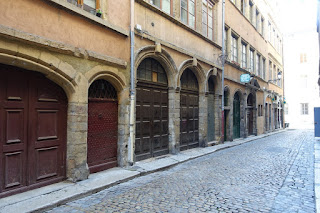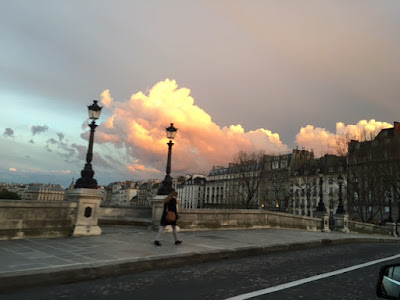Situated at the confluence of the Rhône and Saône Rivers, Lyon's history dates back to Roman times, when it became the capital of Gaul. There are still Roman ruins around the city, as well as tributes and memorials to the many Christians they martyred. In fact, religious uprisings (and their brutal destruction) are sprinkled throughout the city's history. Now a UNESCO World Heritage Site, Lyon was also historically famous for its importance as a centre for the production and weaving of silk. And during WWII, under Nazi occupation, the town became a major stronghold of the Resistance.
Today, Lyon is better known as a serious gastronomical destination for "foodies", as well as being a banking and pharmaceutical centre. One look at this pretty view from our hotel window, and we quickly set out to make the most of our brief visit. First stop was the funicular train ride up to the Basilica Notre-Dame de Fourvière that dominates the hilltop overlooking the city.
The imposing building dates only to the late 19th century, but it replaces several earlier churches all the way back to the original one, built on the same site in the 12th century. To the right, a small chapel from that earlier era remains, with its gold statue of the Virgin Mary on its spire. Fourvière, known as "la colline qui prie" (the hill that prays), became hallowed ground for pilgrimages, for religious feasts, and a place for bishops to take their vows, all of which continue today.
And, even under storm-cloud skies, it offers an expansive view of the city of Lyon from just outside the Basilica.
A winding footpath leads you back to the old city (Vieux Lyon), switch-backing its way down the steep hill. Spring foliage was definitely more advanced here than in Paris!
The old city is a maze of cobbled streets, cosy cafés, little shops, a Theâtre Guignol (puppet theatre) and other charming attractions.
Certain streets, deserted like this one, with doors and windows closed, held some interesting secrets. Who knew that behind the small, anonymous red door on the left...
...lay an intricate, winding tunnel ("traboule") that links several buildings and one street to another, full of private apartments.
In this particular one, there's even a courtyard in the middle with daylight streaming down. During WWII, members of the Resistance used these "traboules" to escape from the Gestapo.
Continuing our stroll, we were equally astonished to pass this window, with full-size models from the "Hellboy" movies (made by Matthew's colleague, Guillermo del Toro). We had arrived at the entrance to the Musée Miniature et Cinéma! Needless to say, we went right in.
The "Miniature" part of the museum's name led us to several rooms full of the most exquisite "scenes" built with infinite detail on the tiniest of scales. This cellar is alive with unsettling atmosphere, full of all kinds of creepy stuff...
...and this Museum of Natural History replica of a Dinosaur Hall just takes your breath away.
To give an idea of the scale, here's the cover of the museum brochure, with the founder of the museum and builder of these exquisite miniatures (and artist extraordinaire), Dan Ohlmann, superimposed in full size in his dinosaur set!!
In the cinema section, we found room after room of original, actual size movie props, all of them celebrating the world of "special effects", from way before the era of computer generated effects. So, there were Gremlins...
...the full-size Alien Queen from James Cameron's "Aliens", here being touched up by Dan Ohlmann...
...and he even has one of the giant cockroaches from "Mimic", which Matthew co-wrote with Guillermo del Toro!
Suddenly, coming round a corner, with a stepladder on his shoulder, who should we run into but Dan Ohlmann himself. He was thrilled to meet us, and we hatched a plan to send the baby dragons from "Dragonslayer" for him to restore and display. Serendipity, again!
And speaking of "cinema", Lyon is the birthplace of the Lumière brothers, Auguste and Louis, inventors of the Cinématographe, the origin of "moving pictures".
Their beautiful family home, built in 1902, is now a museum, dedicated to the many machines they created that succeeded not only in recording movement on film, but also projecting it for audiences.
Their film La Sortie des ouvriers de l’usine Lumière (“Workers Leaving the Lumière Factory”) from 1895, is considered the first motion picture.
Along with the original machine in its simple brown wooden box on a wooden tripod...
...were several others, mounted like crazy sculptures...
...there were sketches that showed how the Cinématographe "movies" were projected (hand cranked) out of the same box...
...and posters advertising their film stock, "Lumichrome Lumière", which had been a mainstay of their business from the beginning.
The museum is a real treasure trove of all things photographic, from the late 19th century and on into the 20th. Certainly the crowning feat was the first public (and paying) film projection of a moving picture, held at the Salon Indien du Grand Café in Paris in December 1895.
Early the following year, the brothers opened Cinématographe theatres in London, Brussels, Belgium and New York, and the world was changed forever.
Another local Lyon luminary, born to an aristocratic Catholic family, is Antoine de Saint-Exupéry (1900-1944), whose books "Vol de Nuit" and "Terre des Hommes" I studied in French at High School. Those books were not readily visible in Lyon, but there was no shortage of cute "Le Petit Prince" books and plenty of goodies for grandkids!
In another part of the city, an area called Croix Rousse, you can still find remnants of what was for a large part of the 19th century (and earlier) the centre of the bustling silk weaving industry. Rather than factories, dozens and dozens of family-owned "ateliers" (workshops) filled the neighborhood. The looms would be set up on the main floor, the family would live in adjacent rooms. This atelier is known as the "Soierie Vivante" (Living Silk Workshop), a reference to the determination of one woman to keep the history of this important industry alive.
Madame Henriette Dunoyer Letourneau was born in this atelier in 1912, the daughter of silk weavers, who owned the magnificent walnut wood looms. She began working in the atelier in 1925, at the age of 13 and continued working until 1980 (55 years!), when she retired. No one was willing to take over the workshop, so she sold it to the city of Lyon with the idea that they would create a cultural centre. Alas, the city had no funds, and the atelier remained closed for more than ten years, and was on the verge of being dismantled, when Mme Letourneau -- thankfully still alive -- rallied a group of volunteers to buy back the looms and open the space up to visitors.
Today, you can spend an enchanting hour examining the looms, learning how they are set up -- truly, machines of hundreds of moving parts -- and seeing some of the finished products.
Our guide led us through the complicated process of designing a pattern, then transferring it onto linked pieces of cardboard, with punched holes...
...that get loaded on top of the loom and then feed down to direct the order of the warp and weft. So complex!
The colored silks were just dazzling, slightly different shades of yellow, lined up and threaded into the loom.
The finished ribbons, each with their own pattern, reflect the intricacy of some of the patterns..
I liked this lovely, if somewhat faded, poster that leads the eye through the entire process from butterfly to silk fabric: "du papillon au tissu de soie". What a magical transformation!
And then, there was the food! Lyon is considered an international centre of grastronomy today, with restaurants, or "bouchons" almost on every street corner. In the most authentic of them, traditional Lyonnais food is served -- heavy on the meat: sausage, duck paté, pork, lots of creamy sauces. Somehow in barely 48 hours, we managed to feast on some delicious dishes:
At the charming Bistrot de Lyon, Matthew devoured a plate of Boeuf Bourguignon, the most delicious he'd ever had, he claimed.
Meanwhile, I opted for the locavore menu, whereby all the ingredients were from within 60 miles of Lyon. Braised stuffed veal breast, mashed potatoes with sage, and spinach.
Dessert featured kiwis (not exactly native to the region, but raised there!) some baked, some whipped into chantilly and meringue, some rendered as a sauce dribbled around.
A bottle of local Beaujolais (50 cl) was included with my meal that cost all of 26 euros!
At lunch the next day at a nice café in the Croix Rousse neighborhood, we all went for the truly traditional Quenelles de Brochet -- pike dumplings, dipped in batter, and poached in a langoustine sauce. (Are you hungry yet?!)
Our last evening, we ate with a charming Lyonnais couple at the Café Comptoir Abel, where I went for this simply cooked chicken with a seasoned béchamel sauce, served with carrots and leeks. Just like "Grandma" would have made!
And this handsome bottle of Olivier Depardon Morgon wine "Charmes" was perfect with everybody's food.
Despite so much gluttony, we somehow staggered onto the train the next day for the short ride down to Valence in the Drôme Departement of France. After the historic and architectural beauty of Lyon, Valence seemed much more subdued, except for the stunning views over to the next Departement -- Ardeche -- with its rugged mountains and forests.
Here the International Festival of Screenwriters takes place every year over four days.
Friday morning, Matthew and his interviewer, Noëlle Deschamps went over their instructions with the Festival Director for his "Master Class"...
The auditorium was packed with eager young students...
...and Matthew did not disappoint, with tales of Hollywood and loads of good advice, and all in French. Chapeau, Matthew!
However, beautiful sunsets can be found in almost any part of Paris, on almost any day.
À bientôt!




















































Oh how I love your posts. I did research on Lyons a year or so ago, and never made it there. This is better than anything else I read. Thank you!
ReplyDeleteThis comment has been removed by the author.
ReplyDeleteSounds like a fantastic trip. Bisoux
ReplyDeleteAnother amazing post x
ReplyDelete